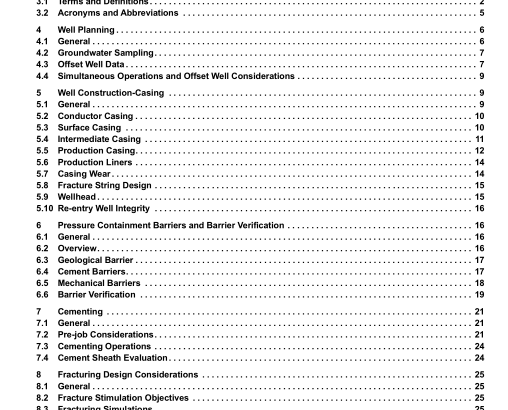API 100-1:2020 pdf free download.Hydraulic Fracturing—Well Integrity and Fracture Containment
The drilling engineer should have additional subsurface information such as the following:
a) the depth of the useable quality groundwater protection typically obtained from the local regulatoryagencies;
b) formation tops;
c) pore pressure and fracture gradient plots;
d) current or potential problem zones such as injection, loss, corrosion, and flow;
e) various other information specific to the local area.
4.1.3 needed to drill the well. The importance of having a complete drilling program and preliminary completion design prior to starting a well cannot be overemphasized. The thoroughness with which wells are planned will contribute greatly to the successful and safe accomplishment of the project objectives.
The multi-discipline team shall recognize the distinct character of each well and design the well plan accordingly. The drilling program should contain the important data required to reach the geological and completion objectives in the safest, most economical manner. Each phase of the operation shall be analyzed for possible problems, potential risks, and mitigation actions developed by the multi-disciplinary team to determine the optimum design. The plan should highlight any potential hazards along with appropriate contingency plans.
The 4.1.4 program must be planned to comply with applicable regulations as well as the operator’s policies and practices. When executed properly, the well will provide the necessary containment for fracture stimulation. Additionally, internal and external stakeholder involvement early in the planning phase can result in 4.1.5 improved overall project performance (see API 100-2 and API 100-3). Advanced planning is typically required for regulatory and legal notifications particular to local requirements for various phases of the operations; these should be part of the project scheduling time line. After the well is drilled and prior to fracture stimulation, a review and confirmation of the actual well 4.1.6 construction including barriers should be undertaken to confirm that the well integrity and fracture containment are within specifications for the actual planned fracture stimulation.
4.2 Groundwater Sampling Once the location for a well has been selected and before the well is drilled, groundwater sources should be identified. Additionally, rivers, creeks, lakes, ponds, and nearby water wells should also be identified. If the operator elects to conduct baseline groundwater sampling, it should be completed prior to initiating fracturing operations. See API 100-2 for more detail on groundwater sampling.
4.3 Offset Well Data General
4.3.1 Offset information should be gathered and reviewed. Proximity of offset wells, offset water wells, and other potential hazards need to be identified and the risks evaluated. Wells that are operating or abandoned (including orphaned wells) that are near current drilling and hydraulic fracturing operations pose potential risk to containment of fracturing and well fluids. Well collision (inadvertent intersection of two wellbores) is not addressed in this section. Operators should establish an area of investigation (AOI) around each well being drilled and hydraulically fractured to assess and mitigate potential risks.
4.3.2.2 The AOI height is controlled by one or more confining layers (geologic barriers) above which the fracture will typically not grow. The AOI length (perpendicular to the direction of fracture propagation) will be controlled by the length of the well (for horizontal wells) with minimal additional length beyond the toe of the well. The AOI width (in the direction of fracture propagation) will have the largest uncertainty and thus will require the largest safety factor. AOI width applies to both vertical and horizontal wells. For vertical wells with uncertain direction of propagation, the AOI length and width are the same.
4.3.2.3 Within the AOI, the operator should identify well penetrations as well as potentially non-sealing faults prior to drilling. In new exploration areas, there may be no wells. In many areas, however, there may be many wells and identifying each well, its location and its condition may be difficult. Methods to locate wells within an AOI includes, but is not limited to the following:
a) company records;
b) records of offset operators;
c) public databases;
d) regulatory agency records;
e) maps;
f) air or satellite photograph;
g) landowner interviews.API 100-1 pdf download.API 100-1:2020 pdf free download
